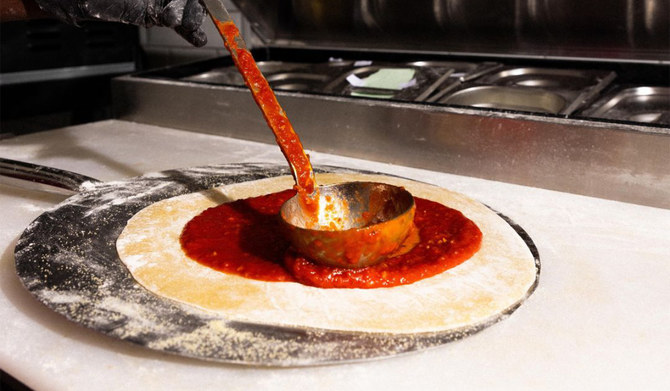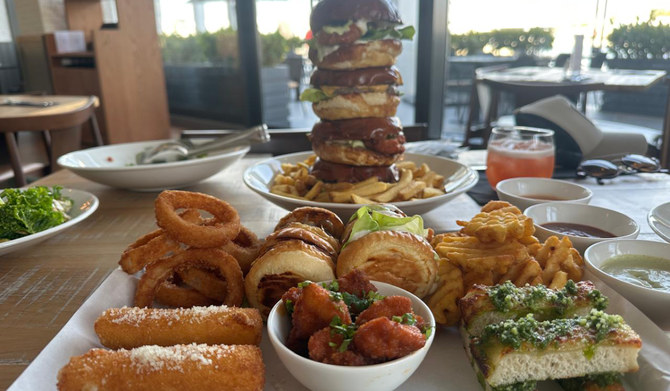
Kristin Vukovic
Chef Thuy Pham’s hair is a stunning shade of lavender, inspired by a gluten-free, chickpea-based cakemade of ube (purple yam) and strawberry, a new dessert on her menu at Mama Đút in Portland, Oregon. “All my food is inspired by my life experiences,” Pham said.
The hair stylist-turned-chef has been serving Vietnamese vegan street food since 2020. Pham’s rise was meteoric: she was a semi-finalist for the James Beard Award for Emerging Chef in 2022, and that same year, Mama Đút became the first vegan business to be featured on Netflix’s Street Food: USA series.
[jump to recipe]Pham – a Vietnamese refugee who immigrated to Portland at age two – didn’t set out to be a chef. In fact, she was a thriving hair stylist. When the pandemic hit, her decade-long career was stalled when salon services shut down. With extra time on her hands, she pursued her passion for cooking, watching videos on how to make vegan pork belly and testing recipes for many vegan dishes.
Her then seven-year-old daughter, Kinsley, encouraged Pham to make her version of vegan pork belly on Instagram Live as a way to continue engaging with her salon clients. But Pham never intended to sell the vegan pork belly. “It wasn’t until some of my followers asked if they could buy some that I got the idea to sell it to make ends meet,” she said. Pham’s DMs flooded with orders and inspired her business, Mama Đút – an English-Vietnamese phrase her family uses that means “Mama, feed”.
The next few months were a whirlwind. When Pham turned 40 in April 2020, she moved into her first commissary kitchen to accommodate growing demand, and four pop-ups at various locations followed. That autumn, Pham’s friend, Aaron Adams of Fermenter, offered her his old deli space in south-east Portland and she opened doors in early November.
“The bulk of the things that I cook is based off of memories of cooking with my mom, and what my mom would eat,” Pham said, explaining that her food is a reflection of her cultural background. “I’m a Vietnamese girl living in America and my food is authentically me, which is Vietnamese American.”
Pham’s mother’s cooking is a regional Vietnamese mix; her mother was born and grew up in northern Vietnam, not far from Hanoi, but moved south to the Mekong Delta right before the Vietnam War. “So much of my food and my identity straddles between American and Vietnamese, but then [it is] also regional within the Vietnamese culture, too,” Pham said.
Her bánh xèo (Vietnamese turmeric crepes) recipe embodies this regional blending, featuring ingredients like mung beans, which are popular in the Mekong Delta area, and julienned green mangoes and rice paper for rolling, which are distinctly northern.
In Vietnam, bánh xèo varies regionally and relies on fresh, local ingredients. According to Pham’s mother, the Mekong Delta version is “the original Bánh Xèo of Vietnam” and features large, crispy turmeric crepes filled with pork belly, shrimp, mung beans, bean sprouts and herbs (she says a specific area in south-west Vietnam also uses duck). In central Vietnam, Pham’s mother says the crepes are smaller, thicker and devoid of turmeric, filled with a medley of seafood and often accompanied by a fermented fish dipping sauce with crushed pineapple. Turmeric also makes an appearance in the northern Vietnamese version, with fillings more in line with the Mekong Delta style (pork and shrimp), often including taro.
Regardless of the region, bánh xèo are a street food staple throughout the country. While the dish’s exact origins are ambiguous, it’s widely accepted that it was invented in central Vietnam during the Tay Son era (1771-1802).
Xèo means “sizzling” in Vietnamese, and when the batter hits the hot skillet, it should sizzle audibly. “You hear and smell bánh xèo before you even see it,” Pham said. “You hear the sizzle, and you smell the coconut and the turmeric, and the savoury umami of the filling.” She remembers waking up on weekend mornings and following her nose to the kitchen where her mother was cooking the dish. “I eat bánh xèo to remember the good times.”
When Pham became vegan in 2019, she sought to “veganise” some of her favourite Vietnamese dishes. Initially, Pham was concerned that the vegan lifestyle would preclude eating some of the food that was close to her heart, but while researching Vietnamese cuisine, she discovered centuries-old vegan traditions that had been lost. “I thought it would further remove me from my identity as a Vietnamese person,” she said. “But it did the complete opposite, and in return, it brought me closer to my identity and my understanding of my Vietnamese roots.”
Pham’s culinary career is burgeoning, with a new Mama Đút location opening in Portland this spring that will serve bánh xèo and other Vietnamese-inspired vegan options. She explained that Portland’s food community, especially in the vegan world, comes together to support its local creators. “I don’t know if I would have been able to thrive in the way that I have had I not done this in Portland first,” Pham said.
“I always tell people, I didn’t choose this life, this life chose me,” Pham said.

Bánh Xèo are sizzling golden crepes made with mung beans, mushrooms and crispy jicama (Credit: Thuy Pham)
Bánh Xèo: Vietnamese turmeric crepes
By Thuy Pham
Serves 8
Much of this recipe can be prepared in advance. The fillings and batter can be refrigerated overnight, and the dipping sauce can be made up to five days ahead.
Method
Step 1
First, make the batter. In a large mixing bowl, combine the rice flour, corn flour, spring onions, sugar, turmeric, MSG and salt.Pour in 2 cups cold water and mix until combined. Stir in the coconut milk and Coco Rico or beer until well combined. Cover and refrigerate for at least 1 hour.
Step 2
Make the filling. Drain and rinse the soaked mung beans. Add the mung beans to a small saucepan and add water 5cm (2 in) above the top of the mung beans. Cook on medium-low heat, stirring occasionally to avoid burning the bottom. Once the mung beans start to simmer, turn the heat down to low and cook uncovered until the mung beans are soft and tender, about 15-20 minutes (think mashed potatoes consistency.)Transfer the mung beans to a bowl and let cool for at least 1 hour. After the mung bean has cooled down, add the fried shallots and mix well. Set the mung bean paste aside for crepe assembly.
Step 3
Heat the 1 tbsp of oil in a large non-stick pan or well-seasoned cast-iron frying pan over high heat. Add the onion, shallots, and garlic and sauté until the onions and shallots start to become translucent, 30-60 seconds. Add the mushrooms, fish sauce, pepper and MSG and sauté over medium heat until tender and lightly browned, 4-5 minutes. Transfer the mushroom filling to a bowl and set aside for assembly.
Step 4
In a separate small bowl, mix the bean sprouts and julienned jicama. Set aside for the crepe assembly.
Step 5
Make the dipping sauce. Add the sugar and garlic to a medium bowl.Add ¼ cup warm water and stir to dissolve the sugar.Add the fish sauce, lime juice and ½ cup cold water and mix until combined. Season with chilli garlic paste to your liking. (The dipping sauce can be refrigerated for up to 5 days.)
Step 6
Set a cooling rack over a sheet pan. In a medium non-stick or cast-iron frying pan, heat 1 tbsp oil over medium-high heat until sizzling. Add ¼ cup of the mushroom filling and spread it evenly over half of the pan. Pour ½ cup batter into the centre of the pan and, working quickly, tilt the pan in a circular motion to spread the batter evenly, with the edges slightly thinner. Cook until the batter starts to set, about 3 minutes. Add your preferred amount of mung bean paste and ¼ cup of the bean sprouts and jicama mixture to one half of the crepe.
Step 7
Cook until the crepe is crispy and has golden edges, 1-2 minutes more. Slide the crepe from the pan onto the cooling rack, allowing it to fold in half to enclose the filling. Let cool for 1 minute before plating. Repeat the process until all the batter and filling have been used, adding more oil for each crepe.
To serve:
Place 1 crepe on a plate. Arrange the cos lettuce, mint, coriander and cucumbers around the crepe with the dipping sauce on the side. To eat, fill the lettuce leaves with pieces of crepe, herbs, and cucumbers and enjoy with the dipping sauce. If desired, soften the rice paper according to package directions and fill with pieces of crepe and herbs, julienned mangos and cucumbers.
Note:
Fried shallots are available at most Asian markets. To make at home, thinly slice shallots and pan fry in oil over medium high heat until dark golden brown.
Courtesy: BBC








